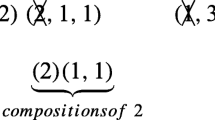Abstract
Let \({{\mathcal S}}\) be one of the two multiplicative semigroups: M × M Boolean matrices, or the semigroup of M × M matrices over the field GF(2). Then for any matrix \({A\in {\mathcal S}}\) there exist two unique smallest numbers, namely the index and period k, d, such that A k = A k+d. This fact allows us to form a new statistical test for randomness which we call the Semigroup Matrix Test. In this paper, we present details and results of our experiments for this test. We use Boolean matrices for M = 2, . . . , 5, and matrices over GF(2) of the size M = 2, . . . , 6. We also compare the results with the results obtained by the well-known Binary Matrix Rank Test.
Similar content being viewed by others
References
Abramowitz M, Stegun IA (eds) (1970) Handbook of mathematical functions. Dover, New York
Cycle detection. http://en.wikipedia.org/wiki/Cycle_detection
Davis RM (1951) The Euler–Fermat theorem for matrices. Duke Math J 18: 613–617
Dichtl NM Document NES/DOS/SAG/WP2/023/2. Description of general NESSIE test tools. SIEMENS AG, Munich. http://www.cryptonessie.org
Grošek O, Šiška J (2002) Signature schemes based on matrices. Congressus Numernatium, pp 154–159
Gustavson H, Dawson E, Nielsen L, Caelli W (1998) A computer package for measuring the strength of Ciphers. J Comp Secur 8(13): 667–697
Heyber B (1996) Cryptometry—statistical tests for crypto-primitives. 6th IEEE, Japan-Benelux workshop, Essen, 8.1–8.3. ISBN 90-74249-09-4
Landsberg G (1893) Ueber eine Anzahlbestimmungund eine damit zusammenhängende Reihe. J reine angew Math 111: 87–88
Marsaglia G (1997) http://stat.fsu.edu/~geo/diehard.html
Marshall IB (1939–1941) On the extension of Fermat’s theorem to matrices of order n. In: Proceedings of the Edinburgh Math Soc 6, pp 85–91
Maxfield MW (1951) The order of a matrix under multiplication (modulo m). Duke Math J 18: 619–621
Niven I (1948) Fermat’s theorem for matrices. Duke Math J 15: 823–826
NIST (2001) A Statistical test suite for random and pseudorandom number generators for cryptographic applications. Special publication, pp 800–822. http://csrc.nict.gov/encryption/aes/
Schwarz Š (1970) On the semigroup of binary relations on a finite set. Czech Math J 20(95): 632–679
Schwarz Š (1974) Sums of powers of binary relations. Mat. Čas. 2(24):161–171 (in Russian)
Schwarz Š (1980) The Euler–Fermat theorem for the semigroup of circulant boolean matrices. Czech Math J 30(105): 135–141
Schwarz Š (1985) Fermat’s theorem for matrices revisited. Math Slovaca 4(35): 343–347
Schwarz Š (1981) The role of semigroups in the elementary theory of numbers. Math Slovaca 4(31): 369–395
Author information
Authors and Affiliations
Corresponding author
Additional information
This material is based upon work supported under grant No. VEGA 1/3115/06 and the grant NIL-I-004 from Iceland, Lichtenstein and Norway through the EEA Financial Mechanism and the Norwegian Financial Mechanism.
Rights and permissions
About this article
Cite this article
Grošek, O., Vojvoda, M. & Krchnavý, R. A new matrix test for randomness. Computing 85, 21–36 (2009). https://doi.org/10.1007/s00607-009-0033-z
Received:
Accepted:
Published:
Issue Date:
DOI: https://doi.org/10.1007/s00607-009-0033-z



